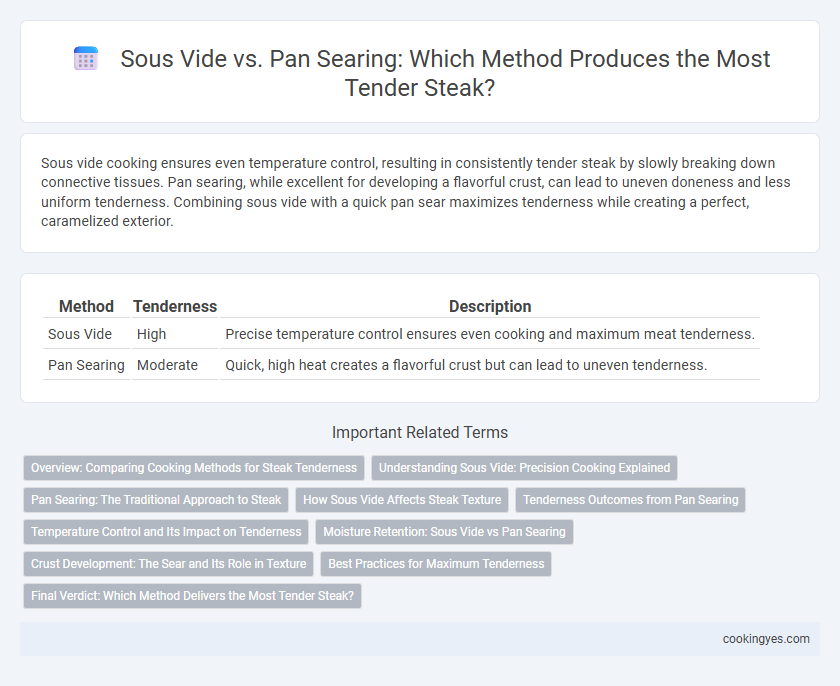Sous vide cooking ensures even temperature control, resulting in consistently tender steak by slowly breaking down connective tissues. Pan searing, while excellent for developing a flavorful crust, can lead to uneven doneness and less uniform tenderness. Combining sous vide with a quick pan sear maximizes tenderness while creating a perfect, caramelized exterior.
Table of Comparison
| Method | Tenderness | Description |
|---|---|---|
| Sous Vide | High | Precise temperature control ensures even cooking and maximum meat tenderness. |
| Pan Searing | Moderate | Quick, high heat creates a flavorful crust but can lead to uneven tenderness. |
Overview: Comparing Cooking Methods for Steak Tenderness
Sous vide cooking ensures even temperature control, resulting in exceptionally tender steaks by gently breaking down connective tissues over extended periods. Pan searing, while quick, creates a flavorful crust but can risk uneven doneness and less consistent tenderness. Combining sous vide with a finishing pan sear optimizes both tenderness and surface caramelization for superior steak quality.
Understanding Sous Vide: Precision Cooking Explained
Sous vide cooking involves vacuum-sealing steak and cooking it in a precisely controlled water bath at a consistent low temperature, ensuring even doneness and maximum tenderness. This method allows the collagen in the meat to break down slowly without overcooking the exterior, resulting in a consistently tender texture throughout. Compared to pan searing alone, sous vide offers superior control over internal temperature, minimizing the risk of toughness and uneven cooking.
Pan Searing: The Traditional Approach to Steak
Pan searing remains the traditional approach to steak, prized for its ability to develop a rich, caramelized crust through the Maillard reaction, which enhances flavor and texture. This method relies on high heat to quickly seal the surface, locking in juices and providing a satisfyingly crisp exterior while maintaining a tender interior. Compared to sous vide, pan searing offers an immediate, hands-on cooking experience that results in a robust, savory steak with complex aromas.
How Sous Vide Affects Steak Texture
Sous vide cooking enhances steak tenderness by precisely controlling temperature, allowing collagen to break down evenly without overcooking the muscle fibers. This method results in a consistent texture throughout the steak, eliminating the risk of dry or tough edges common with traditional pan searing. Sous vide's slow, low-temperature bath transforms tougher cuts into succulent, melt-in-the-mouth experiences unmatched by conventional high-heat cooking techniques.
Tenderness Outcomes from Pan Searing
Pan searing enhances steak tenderness by rapidly caramelizing the surface, creating a flavorful crust that locks in juices and prevents moisture loss. This high-heat method promotes the Maillard reaction, which breaks down muscle fibers and connective tissues, resulting in a more tender bite. Studies show that steaks pan seared after sous vide cooking retain improved tenderness due to the precise temperature control and immediate crust formation.
Temperature Control and Its Impact on Tenderness
Sous vide excels in precise temperature control, allowing steak to cook evenly to the exact desired doneness, preserving moisture and enhancing tenderness by breaking down connective tissues gently over time. Pan searing uses high heat that can develop a flavorful crust but risks overcooking the interior, leading to uneven tenderness and potential toughness. The controlled low-temperature environment of sous vide significantly improves tenderness compared to the rapid, less consistent heat application in pan searing.
Moisture Retention: Sous Vide vs Pan Searing
Sous vide cooking excels in moisture retention by gently heating steak at a precise, low temperature, preventing juice loss and ensuring consistent tenderness throughout. Pan searing, while adding a flavorful crust, can cause more moisture evaporation and uneven cooking when done at high heat. This difference makes sous vide the preferred method for maximizing steak's succulence and tenderness.
Crust Development: The Sear and Its Role in Texture
Sous vide cooking ensures precise temperature control for optimal tenderness by evenly cooking the steak edge-to-edge, while pan searing creates a Maillard reaction that forms a flavorful crust essential for textural contrast. The sear develops a caramelized, crispy exterior that enhances mouthfeel and locks in juices, complementing the steak's tender interior achieved through sous vide. Combining sous vide with a final pan sear maximizes tenderness with a rich, savory crust that pan searing alone cannot consistently produce.
Best Practices for Maximum Tenderness
Sous vide cooking ensures precise temperature control, resulting in evenly tender steak by slowly breaking down muscle fibers without overcooking. Pan searing adds a flavorful crust through the Maillard reaction but requires careful timing to avoid toughness. Combining sous vide with a quick, high-heat pan sear maximizes tenderness while enhancing flavor and texture.
Final Verdict: Which Method Delivers the Most Tender Steak?
Sous vide cooking consistently delivers the most tender steak by evenly cooking the meat at a precise temperature, preserving moisture and breaking down connective tissues without overcooking. Pan searing excels in developing a flavorful crust but can lead to uneven doneness and tougher edges when cooked for extended periods. Combining sous vide with a quick pan sear maximizes tenderness while providing the best texture and flavor.
Sous Vide vs Pan Searing for Tenderness Infographic

 cookingyes.com
cookingyes.com